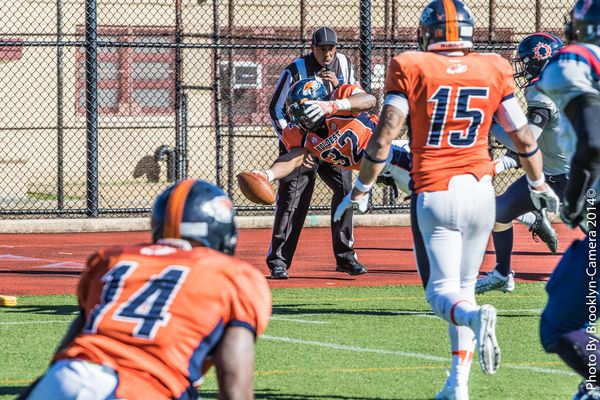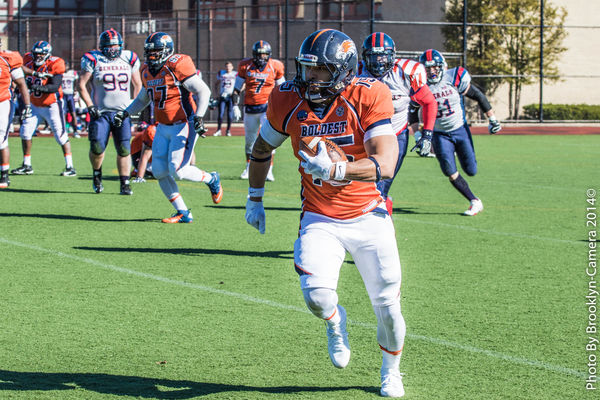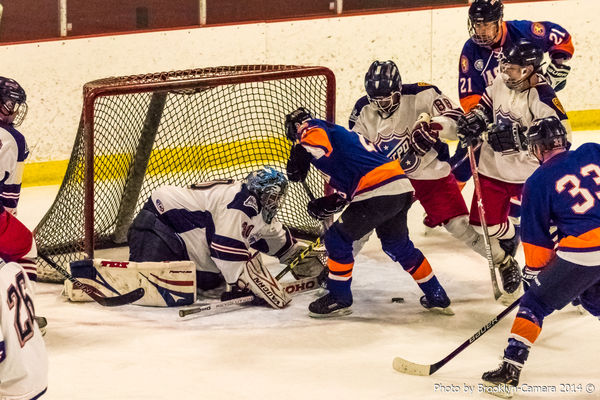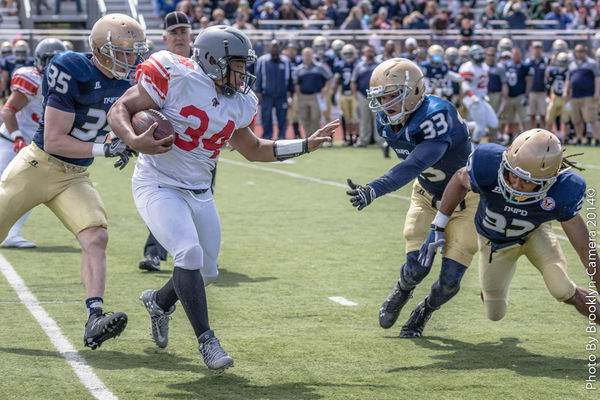Recommendations for sports camera
May 21, 2017 23:27:37 #
Cdouthitt wrote:
what, having a stabilized image of what you're trying to shoot handheld wouldn't be a benefit for a dslr... I don't buy that. I guess that's why DSLR's are DTM (dead to me).
At 600mm (ff equivalent) I know that I find it to be extremely handy for framing my subject.
At 600mm (ff equivalent) I know that I find it to be extremely handy for framing my subject.
I don't disagree - just responding to your comment specifically mentioning EVFs, which is not applicable to DSLRs. I do agree that with either type of viewfinder, a stabilized image is nice to have, especially with very long lens such as a 600mm where keeping the target in the FOV can be a challenge. I love the IS on my 100-400 (especially with a 1.4 TC) when shooting relatively stationary objects at full FL - it allows lower shutter speed and ISO which reduces noise. On the other hand, when shooting sports at 200mm, it just doesn't matter to me. I'm not focusing, just keeping the subject in the FOV with the focus point on the subject and trying to anticipate when the action will occur and shoot.
Btw, the real answer to freezing the motion in fast sports with low noise in a mediocre light environment is a fast lens and a full frame body (lower noise at high ISO), but we're discussing crop bodies here... Once you've chosen a required shutter speed to freeze the action, and picked the widest aperture lens available (or the aperture necessary for the required DOF), your only option to reduce noise and improve IQ is a good high ISO low noise body.
May 22, 2017 02:06:36 #
May 22, 2017 08:44:13 #
amfoto1
Loc: San Jose, Calif. USA
Canon 7D Mark II is what I use for lots of sports shooting and would recommend. It's a 20MP camera with high end build quality (mostly metal, better sealed for dust/weather resistance, 200,000 click-rated shutter). It has a high performance 65-point AF system, all "cross type" and -3EV capable, that's excellent for sports/action. Like Canon's pro-oriented 1D models, it uses a separate chip to drive the AF system (as well as dual processors to handle the images at high frame rates). 7DII is currently selling for about $1550.
For indoor shooting higher than ISO 1600 will definitely be needed. With my 7DIIs I easily get very usable images at 3200, mostly get usable ones at 6400 and have even gotten good, usable ones at higher. The following is a test that was done at ISO 16000:
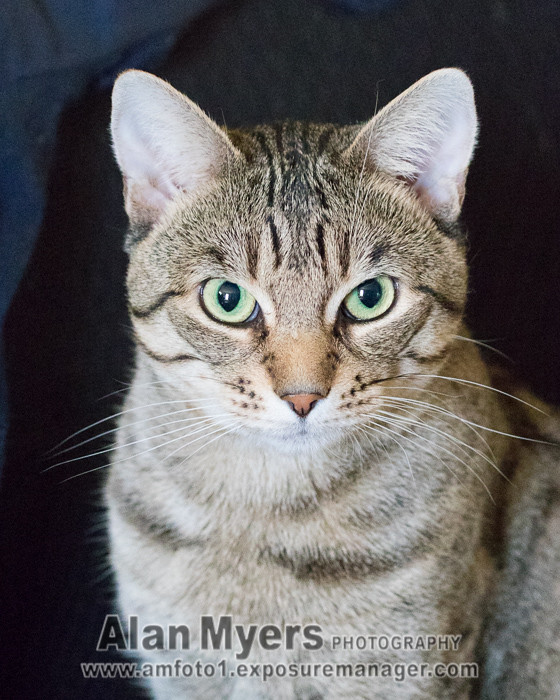

Yes, that's ISO sixteen thousand! Or, it's more than a stop higher than ISO 6400. Sure, there's some noise, as you can see in the enlargement detail on the right. But I think it's pretty well controlled and prints up to around 8x10 are pretty darned good. The above image was shot RAW with care to avoid underexposure, then post-processed via Lightroom 6 with the default noise reduction settings of the software. A "furry" subject helps hide image noise, but the shadows and smooth black areas tend to show it.
I imagine the even newer Nikon D500 could do as well at high ISOs. It's similar to 7DII with 21MP and 10 fps shooting. It has more video related features, is able to do 4K UHD (7DII is 1080P HD) and it has an articulated "touchscreen" LCD (7DII's isn't articulated or touchscreen)... 154 point AF (99 of which are "cross type"), -3EV capable. I haven't used the Nikon, though... so can't really say for sure. The D7200 is the next lower model, more comparable to the Canon 80D I suppose.
For that matter, the Canon 80D is also well worth consideration. It's not far behind the 7DII in performance. Where 7DII can shoot at 10 frames per second, 80D can shoot 7 FPS. But 80D has nearly 20% higher resolution at 24MP. 80D has somewhat fewer AF points: 45 total. But like the 7DII they're all cross type and -3EV. 80D has even more "f/8 capable" points: up to 27 of them, depending upon the lens in use. (7DII has only one f/8 capable point at the center). 80D has an articulated "touch" screen, too (which 7DII lacks). 80D has a slightly lower rated shutter, I'm sure... but I haven't seen any official ratings from Canon. That series is typically fitted with 100,000 click rated shutters.
Even the recent T7i or 77D might be worth consideration. Both have essentially the same 24MP sensor as the 80D. Both have slightly lower spec shutters: 1/4000 top speed and 1/200 flash sync (7D-series and 80D have 1/8000 and 1/250). And they both are slightly slower at 6 frames per second. 77D has control layout and design similar to 80D. T7i control and design are the Rebel-series style, which has a bit less direct access to some functions.
Nikon offers similar step-down models in their D5000 series, I'm sure, though I don't know a lot of the details. I do know that their models below the D7200 are a bit more limited in the lenses they can fully use. Some Nikon lenses don't have an autofocus motor built into the lens itself. Those "D" type lenses (and similar) rely upon a focusing motor built into the camera body instead. Only the D7000-series and higher models have that in-body focusing motor. The D5000 and D3000 series don't, so while those lenses can be used on them, only manual focus will be possible.
There are no limitations of this type with Canon cameras and lenses. All the models mentioned can fully use all Canon EF and EF-S lenses made since the late 1980s, without any limitations at all.
Lenses are going to matter much more than you might think. Especially for sports shooting, lenses can be more important than the camera choice. Be careful not to "over buy" the camera, then "under buy" lenses!
Canon's EF 70-200mm f/2.8 IS USM "II" uses fluorite (like many of their telephoto lenses have for decades). Introduced in 2010, it was called "the best 70-200mm anyone has ever made". It's price has come down a little, now $1900.
Nikon has just recently renovated most of their super telephotos to use fluorite too, including a new Nikkor 70-200mm f/2.8 VR AF-S "FL". Some are now calling this "the best 70-200mm anyone has ever made". It sells for $2800.
70-200/2.8 are pretty hefty, pro-quality lenses. Anyone considering one should try it out in a store and see if they can "live with it". Canon offers an alternative EF 70-200mm f/4 IS USM for $1100 that also uses fluorite to give image quality very close to their f/2.8 II's, but is about 1/3 smaller and lighter weight. I used a Canon 70-200/2.8 a lot for some time, then got a 70-200/4 a couple years ago as a backup. I actually find myself using the f/4 lens more often now.
I'd recommend pairing the telezoom with one or another of several mid-range zooms, which will likely quickly become a "general purpose, walk-around zoom". Canon has several to choose among. For travel, the EF-S 15-85mm IS USM is very versatile, with excellent image quality. One drawback is that it's an f/3.5 to 5.6 lens. But that's what allows it to be fairly compact. Another versatile lens is the EF-S 18-135mm IS USM... often sold in kit with the 80D, it's got a new "Nano" USM focus drive that's both fast for sports/action and extra quiet and smooth for video work. Canon even offers a power zoom module accessory especially for that lens, that a videographer might find useful.
Most other Canon USM (ultrasonic) lenses are fast and very good tracking movement, so ideal for sports... but not so great for video. STM or "stepper motor" lenses that are quieter and smoother can be more desirable for video work... but typically a bit are slower focusing, so not so great for sports/action. Canon offers both types in their 18-135mm and states that the USM version is 2X to 4X faster focusing than the STM version. (There also is a cheaper "micro motor" version, not marked either USM or STM, that's slower and noisier than either of the above.)
For somewhat low light shooting, Canon also offers an excellent EF-S 17-55mm f/2.8 IS USM.
"Large aperture/fast" zooms like this are typically bigger, heavier and have less range of focal length. Prime lenses... instead of zooms... can be even "faster", not as big and not as expensive. For example, Canon EF 135mm f2L USM is a full stop faster than any 70-200/2.8... but smaller than a 70-200/4 and not quite as expensive, either. 100mm f/2, 85mm f/1.8, 50mm f/1.4, 28mm f/1.8 are more examples.
You mention a 50mm lens and that's probably for it's relatively small size, comparatively low price and large aperture. On any of these "APS-C" cameras ("DX" in Nikon), a 50mm acts as a short telephoto... an excellent portrait lens, among other things. Just be aware it's not a "standard" or "normal" lens, the way 50mm was on a film (i.e., "full frame") camera. Canon's EF 50mm f/1.8 STM is an excellent value for about $125. But, even though it's a much older design, the more expensive EF 50mm f/1.4 offers faster AF which might be needed, if planning to use this lens for sports action shooting. (Personally I think 85mm, 100mm or 135mm are more likely lenses to use for indoor sports shooting. I have used 50mm for that too... but less often.)
Finally, I agree with a previous response, the one of the most important new features if planning to do indoor gym shooting is Anti-Flicker. 80D, 7D Mark II and other recent Canon models have "Flicker-Free" mode and I guess recent Nikon models similar. This feature times the shutter release with the cycling of fluorescent and similar lighting. Those lights actually cycle on and off at a 60 Hz rate (120 times per second). It's so fast our eyes typically don't notice... but our cameras sure do! Without anti-flicker, the camera meter is "fooled" a lot, causing poor exposures. Under fluorescent without Flicker-Free I always figured at least half of of my shots would be badly under-exposed. But now using Flicker-Free on my 7DIIs, which detects the peak output of the lighting cycle and times the shutter release to match it, I see far, far fewer exposure problems. It's a great feature for folks who have no choice but to shoot under these types of lighting!
For indoor shooting higher than ISO 1600 will definitely be needed. With my 7DIIs I easily get very usable images at 3200, mostly get usable ones at 6400 and have even gotten good, usable ones at higher. The following is a test that was done at ISO 16000:


Yes, that's ISO sixteen thousand! Or, it's more than a stop higher than ISO 6400. Sure, there's some noise, as you can see in the enlargement detail on the right. But I think it's pretty well controlled and prints up to around 8x10 are pretty darned good. The above image was shot RAW with care to avoid underexposure, then post-processed via Lightroom 6 with the default noise reduction settings of the software. A "furry" subject helps hide image noise, but the shadows and smooth black areas tend to show it.
I imagine the even newer Nikon D500 could do as well at high ISOs. It's similar to 7DII with 21MP and 10 fps shooting. It has more video related features, is able to do 4K UHD (7DII is 1080P HD) and it has an articulated "touchscreen" LCD (7DII's isn't articulated or touchscreen)... 154 point AF (99 of which are "cross type"), -3EV capable. I haven't used the Nikon, though... so can't really say for sure. The D7200 is the next lower model, more comparable to the Canon 80D I suppose.
For that matter, the Canon 80D is also well worth consideration. It's not far behind the 7DII in performance. Where 7DII can shoot at 10 frames per second, 80D can shoot 7 FPS. But 80D has nearly 20% higher resolution at 24MP. 80D has somewhat fewer AF points: 45 total. But like the 7DII they're all cross type and -3EV. 80D has even more "f/8 capable" points: up to 27 of them, depending upon the lens in use. (7DII has only one f/8 capable point at the center). 80D has an articulated "touch" screen, too (which 7DII lacks). 80D has a slightly lower rated shutter, I'm sure... but I haven't seen any official ratings from Canon. That series is typically fitted with 100,000 click rated shutters.
Even the recent T7i or 77D might be worth consideration. Both have essentially the same 24MP sensor as the 80D. Both have slightly lower spec shutters: 1/4000 top speed and 1/200 flash sync (7D-series and 80D have 1/8000 and 1/250). And they both are slightly slower at 6 frames per second. 77D has control layout and design similar to 80D. T7i control and design are the Rebel-series style, which has a bit less direct access to some functions.
Nikon offers similar step-down models in their D5000 series, I'm sure, though I don't know a lot of the details. I do know that their models below the D7200 are a bit more limited in the lenses they can fully use. Some Nikon lenses don't have an autofocus motor built into the lens itself. Those "D" type lenses (and similar) rely upon a focusing motor built into the camera body instead. Only the D7000-series and higher models have that in-body focusing motor. The D5000 and D3000 series don't, so while those lenses can be used on them, only manual focus will be possible.
There are no limitations of this type with Canon cameras and lenses. All the models mentioned can fully use all Canon EF and EF-S lenses made since the late 1980s, without any limitations at all.
Lenses are going to matter much more than you might think. Especially for sports shooting, lenses can be more important than the camera choice. Be careful not to "over buy" the camera, then "under buy" lenses!
Canon's EF 70-200mm f/2.8 IS USM "II" uses fluorite (like many of their telephoto lenses have for decades). Introduced in 2010, it was called "the best 70-200mm anyone has ever made". It's price has come down a little, now $1900.
Nikon has just recently renovated most of their super telephotos to use fluorite too, including a new Nikkor 70-200mm f/2.8 VR AF-S "FL". Some are now calling this "the best 70-200mm anyone has ever made". It sells for $2800.
70-200/2.8 are pretty hefty, pro-quality lenses. Anyone considering one should try it out in a store and see if they can "live with it". Canon offers an alternative EF 70-200mm f/4 IS USM for $1100 that also uses fluorite to give image quality very close to their f/2.8 II's, but is about 1/3 smaller and lighter weight. I used a Canon 70-200/2.8 a lot for some time, then got a 70-200/4 a couple years ago as a backup. I actually find myself using the f/4 lens more often now.
I'd recommend pairing the telezoom with one or another of several mid-range zooms, which will likely quickly become a "general purpose, walk-around zoom". Canon has several to choose among. For travel, the EF-S 15-85mm IS USM is very versatile, with excellent image quality. One drawback is that it's an f/3.5 to 5.6 lens. But that's what allows it to be fairly compact. Another versatile lens is the EF-S 18-135mm IS USM... often sold in kit with the 80D, it's got a new "Nano" USM focus drive that's both fast for sports/action and extra quiet and smooth for video work. Canon even offers a power zoom module accessory especially for that lens, that a videographer might find useful.
Most other Canon USM (ultrasonic) lenses are fast and very good tracking movement, so ideal for sports... but not so great for video. STM or "stepper motor" lenses that are quieter and smoother can be more desirable for video work... but typically a bit are slower focusing, so not so great for sports/action. Canon offers both types in their 18-135mm and states that the USM version is 2X to 4X faster focusing than the STM version. (There also is a cheaper "micro motor" version, not marked either USM or STM, that's slower and noisier than either of the above.)
For somewhat low light shooting, Canon also offers an excellent EF-S 17-55mm f/2.8 IS USM.
"Large aperture/fast" zooms like this are typically bigger, heavier and have less range of focal length. Prime lenses... instead of zooms... can be even "faster", not as big and not as expensive. For example, Canon EF 135mm f2L USM is a full stop faster than any 70-200/2.8... but smaller than a 70-200/4 and not quite as expensive, either. 100mm f/2, 85mm f/1.8, 50mm f/1.4, 28mm f/1.8 are more examples.
You mention a 50mm lens and that's probably for it's relatively small size, comparatively low price and large aperture. On any of these "APS-C" cameras ("DX" in Nikon), a 50mm acts as a short telephoto... an excellent portrait lens, among other things. Just be aware it's not a "standard" or "normal" lens, the way 50mm was on a film (i.e., "full frame") camera. Canon's EF 50mm f/1.8 STM is an excellent value for about $125. But, even though it's a much older design, the more expensive EF 50mm f/1.4 offers faster AF which might be needed, if planning to use this lens for sports action shooting. (Personally I think 85mm, 100mm or 135mm are more likely lenses to use for indoor sports shooting. I have used 50mm for that too... but less often.)
Finally, I agree with a previous response, the one of the most important new features if planning to do indoor gym shooting is Anti-Flicker. 80D, 7D Mark II and other recent Canon models have "Flicker-Free" mode and I guess recent Nikon models similar. This feature times the shutter release with the cycling of fluorescent and similar lighting. Those lights actually cycle on and off at a 60 Hz rate (120 times per second). It's so fast our eyes typically don't notice... but our cameras sure do! Without anti-flicker, the camera meter is "fooled" a lot, causing poor exposures. Under fluorescent without Flicker-Free I always figured at least half of of my shots would be badly under-exposed. But now using Flicker-Free on my 7DIIs, which detects the peak output of the lighting cycle and times the shutter release to match it, I see far, far fewer exposure problems. It's a great feature for folks who have no choice but to shoot under these types of lighting!
May 22, 2017 09:27:49 #
I have been shooting sports via the Canon 7D MKII which is a crop sensor camera. I use the Canon 2.8 70-200mm, Canon 4.5-5.6 100-400mm and also the Canon 4.0
70-200mm when I want to travel lite. Indoors I use the Canon 2.0 135mm, Canon 2.8 24-70mm, happy with the results. Just make sure you do your homework and also check reviews of cameras on YouTube.com. Good luck and have fun...
70-200mm when I want to travel lite. Indoors I use the Canon 2.0 135mm, Canon 2.8 24-70mm, happy with the results. Just make sure you do your homework and also check reviews of cameras on YouTube.com. Good luck and have fun...
capt2575 wrote:
Hello fellow Hog. All the advice you have receive... (show quote)
May 22, 2017 09:38:11 #
SS319 wrote:
While good advice can and will be had here, you ca... (show quote)
All good advice, EXCEPT asking the store that, according to your advice, the OP will have spent at least two hours of the local store's staff time to show and explain the options, to match online pricing. Is the local store's staff time, knowledge and experience not worth anything? SMH
May 22, 2017 09:41:23 #
I'm still curious as to all the replys to the op about getting a dslr. They specially asked about mirrorless.
May 22, 2017 10:25:51 #
TriX wrote:
If you need 1/500 to freeze the motion of a sporti... (show quote)



Ahhhh.... image stabilization allows you to shoot at a LOWER ISO than you could otherwise shoot, everything else being equal. You said as much in your response.
And the SAME principle is at work, whether your are using a DSLR or a mirrorless camera.

May 22, 2017 10:32:21 #
Cdouthitt wrote:
I'm still curious as to all the replys to the op about getting a dslr. They specially asked about mirrorless.
THAT kinda limits the discussion to Sony, Olympus, Fujifilm, and Panasonic... doesn't it?



May 22, 2017 10:36:52 #
CHOLLY wrote:
THAT kinda limits the discussion to Sony, Olympus, Fujifilm, and Panasonic... doesn't it? 





A9, A6500, EM1ii, XT-2, GH5...what specific models would you add to the list?
May 22, 2017 10:40:07 #
Cdouthitt wrote:
I'm still curious as to all the replys to the op about getting a dslr. They specially asked about mirrorless.
Good point. The OP's quote was "mirrorless -?" and his reason for considering mirrorless was his concern of a faster shutter response time. According to tests, a Sony A7 MKII for AF and shutter relaease with center point AF is .221 seconds, the 7D2 under the same conditions is .249 seconds, and the Nikon D500 was fastest of all at .170 seconds, so no obvious advantage for mirrorless in that respect.
May 22, 2017 10:44:18 #
TriX wrote:
Good point. The OP's quote was "mirrorless -?" and his reason for considering mirrorless was his concern of a faster shutter response time. According to tests, a Sony A7 MKII for AF and shutter relaease with center point AF is .221 seconds, the 7D2 under the same conditions is .249 seconds, and the Nikon D500 was fastest of all at .170 seconds, so no obvious advantage for mirrorless in that respect.
also had to do with size and weight...of lenses too.
May 22, 2017 10:47:15 #
CHOLLY wrote:
img src="https://static.uglyhedgehog.com/images/s... (show quote)
Actually what I said was that IF you don't need the faster shutter speed to freeze the action, IS/VR will allow you to shoot at a lower shutter speed, avoiding camera shake, which for a given aperture, implies a lower ISO (and less noise) for a given exposure. Fast sports photography requires a high enough shutter speed that camera shake is typically not an issue at the FLs we're discussing, so no value. In fact, I turn it off under those conditions. You're correct - same issue for DSLRs or mirrorless.
May 22, 2017 10:47:42 #
TriX wrote:
Good point. The OP's quote was "mirrorless -?" and his reason for considering mirrorless was his concern of a faster shutter response time. According to tests, a Sony A7 MKII for AF and shutter relaease with center point AF is .221 seconds, the 7D2 under the same conditions is .249 seconds, and the Nikon D500 was fastest of all at .170 seconds, so no obvious advantage for mirrorless in that respect.
So does that compare to the .108s or .374s of the em1ii?
http://www.imaging-resource.com/PRODS/olympus-e-m1-ii/olympus-e-m1-iiA6.HTM
May 22, 2017 10:55:49 #
Cdouthitt wrote:
also had to do with size and weight...of lenses too.
Sony's 70-200 f2.8 weighs 52.2 Oz and costs $2599 list. Canon's 70-200 f2.8L IS II weighs 52.6 Oz and costs $1899. Nikon's 70-200 f2.8G VRII weighs 54.3 oz and lists for $2099.
May 22, 2017 11:01:07 #
Cdouthitt wrote:
So does that compare to the .108s or .374s of the em1ii?
http://www.imaging-resource.com/PRODS/olympus-e-m1-ii/olympus-e-m1-iiA6.HTM
http://www.imaging-resource.com/PRODS/olympus-e-m1-ii/olympus-e-m1-iiA6.HTM
Clearly faster and a very nice camera if you're shopping for or considering a micro 4/3 body.
If you want to reply, then register here. Registration is free and your account is created instantly, so you can post right away.



